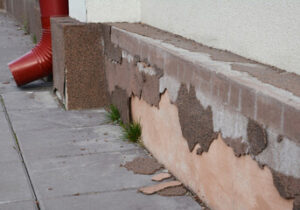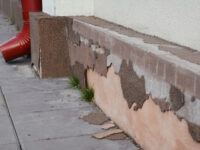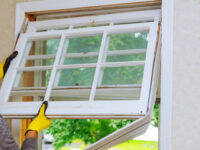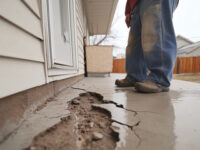Foundation Repair – What You Need to Know
Pros Foundation Repair Greensboro NC addresses issues with a building’s foundation and stabilizes the structure. It can prevent further damage and protect the value of a home or commercial property.
Uneven floors and doors that are hard to open or close can indicate movement in the foundation. Repairing these issues promptly can stop further deterioration and save money on future repairs.
Essentially, underpinning reinforces foundations by spreading the structure’s weight across a larger area of the ground. There are various ways to accomplish this. The method chosen will depend on the soil conditions, amount of settlement, and structural loads.
The most common way to underpin a building is to create additional concrete or steel footings beneath the existing ones. These deeper footings are then connected to the existing ones to enhance stability. This type of underpinning can be used to strengthen an existing foundation, add support for new structures attached to the building or even raise a basement floor.
Other types of underpinning include foundation piers and piling. These methods involve drilling holes into the ground and pushing column like members such as steel or pre-cast concrete into the ground. This is done to transfer the load of the building onto better soil layers with greater load-bearing capacity.
When a home experiences a problem with its foundation, it can lead to serious structural problems that put the entire house at risk. This is why it’s important to address the issue as soon as possible. While there are a number of quick fixes for foundation problems, such as mudjacking or using polyurethane materials, they are not long-term solutions. Foundation underpinning is the best option for a stable, strong and reliable foundation. It can help to keep the house’s value up and prevent further damage to the property. This is especially the case for those who are looking to increase their living space or add a second story to their home.
Sealing Cracks
The first stage of any foundation repair plan is sealing cracks in your home’s walls and floors. Cracks are an indication that your home’s foundation is shifting, and if left unattended, they can become worse and lead to other structural problems throughout the house. Cracks are also a sign that moisture is seeping through the foundation and into your home. Addressing these issues early on helps prevent water damage and maintain or even boost your home’s resale value.
After the repairs, your contractor will apply a waterproof masonry sealer to the cracks. This will help keep water out of the basement and reduce the risk of further damage to your home’s foundation and other structural elements.
Some foundation repair jobs require piers or pilings to be placed under the middle of the house as well, which is called underpinning. A hole will be dug around the foundation, and concrete or steel pilings will then be hydraulically pressed into the ground. These are rebar-reinforced, which makes them more stable and long-lasting than the mudjacking method.
If your home has foundation issues, contact a professional right away for an inspection. Doing so will allow your family to stay in the house while repairs are completed, and it will help protect your home’s value and resale potential. Foundation problems worsen over time, and you’ll likely pay more for repairs the longer you wait. A professional will inspect your property and recommend the best course of action to solve your problem. Then you can rest assured knowing that your home is safe, secure, and functional.
Masonry Patches
For brick walls with crumbling mortar, a masonry patch can be a lifesaver. These can be used to repair a wide range of issues from mismatched bricks to water damage. The key is to match the color of the new mortar to the existing layer and avoid allowing water to seep through the surface. Tuck-pointing (patching new mortar over old without chiseling) is often done by homeowners but is not recommended, as it leaves a weak bond and widens joints, making them more susceptible to water infiltration.
The mortar in a brick wall is not only vulnerable to water damage, but also to hydrostatic pressure pushing against the foundation from below. This can cause seepage through or over the walls and may lead to more serious structural problems. A permanent solution is interior drain tile that alleviates hydrostatic pressure and carries groundwater to a sump pump.
When repairing mortar in brick or stone walls, it is important to use the right materials. Many concrete patch or repair products at the local big box store contain synthetic modifiers and bonding agents that can actually create a barrier between the repair material and the substrate, leading to failure due to freeze-thaw cycles. Cathedral Stone Products uses a high-performance concrete repair product that does not contain latex or acrylic bonding agents and is formulated to closely match the physical characteristics of the original material.
After completing the repairs, the crew will backfill excavated areas, compact and level the soil to prevent future settling and reinstall any removed sections of foundation wall. They will also reinstall outdoor fixtures and plant any landscaping that was disturbed during the process, making sure to leave the property as clean as possible.
Concrete Piers
Piers are structural supports contractors install to help strengthen a home’s foundation and prevent further sinking and shifting. They have a high load-bearing capacity and are best suited for large buildings constructed on frequently wet soil. Contractors use a mix of concrete or steel to create the support structures. Each option has its own benefits and disadvantages. Choosing the right foundation repair professional can lead to a strong and stable pier installation that lasts for years.
Drilled concrete piers have the advantage of reaching far into the ground to reach stable soil layers or bedrock. They transfer the weight of your home to these layers and prevent further stress on the compromised foundation. This solution is ideal for homes in areas prone to expansive clay soil. It also allows plumbers, electricians, and HVAC specialists to access utility lines without digging under your house.
The disadvantage of drilled concrete piers is that they can be susceptible to sinking and shifting. This is especially true if the soil conditions change. In addition, they can be easily damaged by water runoff or hydrostatic pressure. These issues can make it difficult to install and maintain a home’s plumbing, electrical, and HVAC systems.
When choosing a foundation repair company, it is important to find one that has the right combination of experience, expertise, and reliability to perform a thorough pier installation. A reputable professional should also provide a warranty for their work and the products used in the foundation repair. This will give property owners peace of mind that their investment is in good hands and will remain durable for years to come.
Steel Piers
Steel piers are a versatile solution used in foundation repair to support structures. They can be installed in a variety of soil conditions, and they can carry heavy loads without shifting or moving over time. They are also easy to install and can be used for building construction and renovations. When choosing a foundation repair professional to use steel piers, look for one who has experience with these supports and offers competitive prices.
The first step in installing steel piers is clearing the area and preparing for excavation. Foundation repair specialists will measure the location of the support and mark where the piers are going to go. The piers are then driven into place using hydraulic jacks until they reach stable soil or bedrock. After the piers are in place, the foundation footing bottom is backfilled and all visible access points are sealed.
Both concrete and steel piers are effective for stabilizing structures and can minimize differential settlement, but they differ in terms of depth and durability. Foundation repair professionals can assess which type is best suited to a specific property, considering the structure’s load, soil movement, and other factors.
Concrete piers can be used in soil that isn’t too deep and are cheaper than their steel counterparts. However, they aren’t ideal for structures that require deeper stability, and they can be susceptible to moisture damage, making them less durable over time. Steel piers are more expensive upfront, but they offer superior strength and longevity. They can also be installed to address multiple problems at once, which is helpful for saving on labor costs. For maximum performance, it is recommended to maintain concrete piers by examining them regularly for cracking and chipping.






